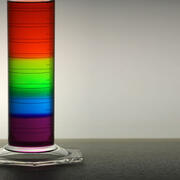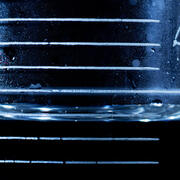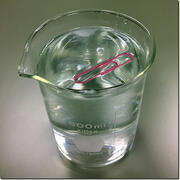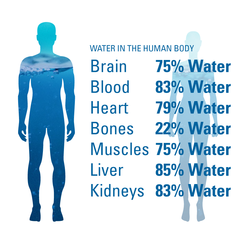Properties of water
Looking at water, you might think that it's the simplest thing around. Pure water is practically colorless, odorless, and tasteless. But it's not at all simple and plain and it is vital for all life on Earth. Where there is water there is life, and where water is scarce, life has to struggle or just "throw in the towel." Continue on to learn about dozens of water properties.
Physical properties • Chemical properties • Related resources • Activities
Water is everywhere, from huge oceans to invisible water molecules making up water vapor in the air. Of course you can see and feel the physical properties of water, but there are also many chemical, electrical, and atomic-scale properties of water that affect all life and substances on Earth. Use this list to investigate the properties of water.
Physical properties
-
Facts About Water
Yes, of course the most obvious fact about water is that it is wet, at least in the liquid state. But, there are many more facts about water that make it a most fascinating substance, one that all life on and in the Earth depends on.Adhesion and Cohesion of Water
Adhesion and cohesion are important water properties that affects how water works everywhere, from plant leaves to your own body. Just remember... Cohesion: Water is attracted to water, and Adhesion: Water is attracted to other substances.Capillary Action and Water
Plants and trees couldn't thrive without capillary action. Capillary action helps bring water up into the roots. With the help of adhesion and cohesion, water can work its way all the way up to the branches and leaves. Read on to learn more about how this movement of water takes place.Water Color
Is pure water really clear? Not really—even pure water is not colorless, but has a slight blue tint to it. In the natural world you often see water that is definitely not clear. Sediment and organics color natural water shades of brown or green. And if too much iron in present, even your drinking water can have a brown hue. Read on to investigate water color in the environment.Water Compressibility
Water is essentially incompressible, especially under normal conditions. Yet, in industrial applications water can be tremendously compressed and used to do things like cut through metal.Water Density
In practical terms, density is the weight of a substance for a specific volume. The density of water is roughly 1 gram per milliliter but, this changes with temperature or if there are substances dissolved in it. Ice is less dense than liquid water which is why your ice cubes float in your glass. As you might expect, water density is an important water measurement.Specific Heat Capacity and Water
Water has a high specific heat capacity—it absorbs a lot of heat before it begins to get hot. You may not know how that affects you, but the specific heat of water has a huge role to play in the Earth's climate and helps determine the habitability of many places around the globe.Water Meniscus
A meniscus is a curve in the surface of a molecular substance (water, of course) when it touches another material. With water, you can think of it as when water sticks to the inside of a glass.Rainbows (Water and Light)
If you are going to find your pot of gold at the end of a rainbow you need to understand why they exist and how they form. Are rainbows just a visual illusion or are they real physical aspects of nature. We will give you the answers.Surface Tension and Water
Surface tension in water might be good at performing tricks, such as being able to float a paper clip on its surface, but surface tension performs many more duties that are vitally important to the environment and people. Find out all about surface tension and water here.Sediment and Suspended Sediment
Water in nature is never really totally clear, especially in surface water, such as rivers and lakes. Water has color and some extent of dissolved and suspended material, usually dirt particles (suspended sediment). Suspended sediment is an important factor in determining the quality of water.Temperature and Water
Water temperature plays an important role in almost all USGS water science. Water temperature exerts a major influence on biological activity and growth, has an effect on water chemistry, can influence water quantity measurements, and governs the kinds of organisms that live in water bodies.Turbidity and Water
Lucky for us all, our drinking water is almost always clear (very low turbidity). Other water, such as the creek behind your house after a rainstorm, is likely to be highly turbid—brown with floating sediment. Turbidity is the clarity of water and it is an important factor in water quality.Vapor Pressure and Water
The vapor pressure of a liquid is the point at which equilibrium pressure is reached, in a closed container, between molecules leaving the liquid and going into the gaseous phase and molecules leaving the gaseous phase and entering the liquid phase. To learn more about the details, keep reading!Water, the Universal Solvent
We need to take the statement "Water is the universal solvent" with a grain of salt (pun intended). Of course it cannot dissolve everything, but it does dissolve more substances than any other liquid, so the term fits pretty well. Water's solvent properties affect all life on Earth, so water is universally important to all of us.
-
Alkalinity and Water
Definition of alkalinity: "The buffering capacity of a water body; a measure of the ability of the water body to neutralize acids and bases and thus maintain a fairly stable pH level"Conductivity (Electrical Conductance) and Water
Water and electricity don't mix, right? Well actually, pure water is an excellent insulator and does not conduct electricity. The thing is, you won't find any pure water in nature, so don't mix electricity and water. Our Water Science School page will give you all the details.Dissolved Oxygen and Water
Dissolved oxygen (DO) is a measure of how much oxygen is dissolved in the water - the amount of oxygen available to living aquatic organisms. The amount of dissolved oxygen in a stream or lake can tell us a lot about its water quality.Hardness of Water
In scientific terms, water hardness is generally the amount of dissolved calcium and magnesium in water. But in layman's terms, you may notice water hardness when your hands still feel slimy after washing with soap and water, or when your drinking glasses at home become less than crystal clear. Learn a lot more about water hardness on the Water Science School site.pH and Water
pH is a measure of how acidic/basic water is. The range goes from 0 to 14, with 7 being neutral. pHs of less than 7 indicate acidity, whereas a pH of greater than 7 indicates a base. The pH of water is a very important measurement concerning water quality.Saline Water and Salinity
In your everyday life you are not involved much with saline water. You are concerned with freshwater to serve your life's every need. But, most of Earth's water, and almost all of the water that people can access, is saline, or salty water. Just look at the oceans and remember that oceans comprise about 97% of all water on, in, and above the Earth.
-
How Much Does a Cloud Weigh?
I don't know anyone who is afraid to walk underneath a cumulus cloud because they are afraid it might fall on them. We don't think of clouds even having weight because they are floating. But, clouds are made up of a physical substance, water, and water is quite heavy, so clouds must have weight. We will explain this "paradox" to you if you read on.Are Raindrops Shaped Like Teardrops?
We all know that raindrops are shaped like teardrops, right? Actually, that is not true. Read on to find out the facts.Raindrops are Different Sizes
You've seen a light mist hanging in the air before. And you've had "full sized" water drops splash you in the face, too. So, raindrops are different sizes, but why? Find out below.The Water in You: Water and the Human Body
Water is indeed essential for all life on, in, and above the Earth. This is important to you because you are made up mostly of water. Find out what water does for the human body.Water in Space: How Does Water Behave in Outer Space?
Does water still feel wet in outer space? Does it float or does it fall? With a little help from our friends at NASA we will help you understand exactly how water behaves in outer space. Continue reading to learn more.
-
Water Properties True/False Quiz
How much do you know about water properties? Take our Water Properties True/False Quiz and find out.Water Properties Questions & Answers
Water is everywhere, from huge oceans to invisible water molecules making up water vapor in the air. Of course you can see and feel the physical properties of water, but there are also many chemical, electrical, and atomic-scale properties of water that affect all life and substances on Earth.Water Properties Photo Gallery
Learn about water's properties using pictures.






























